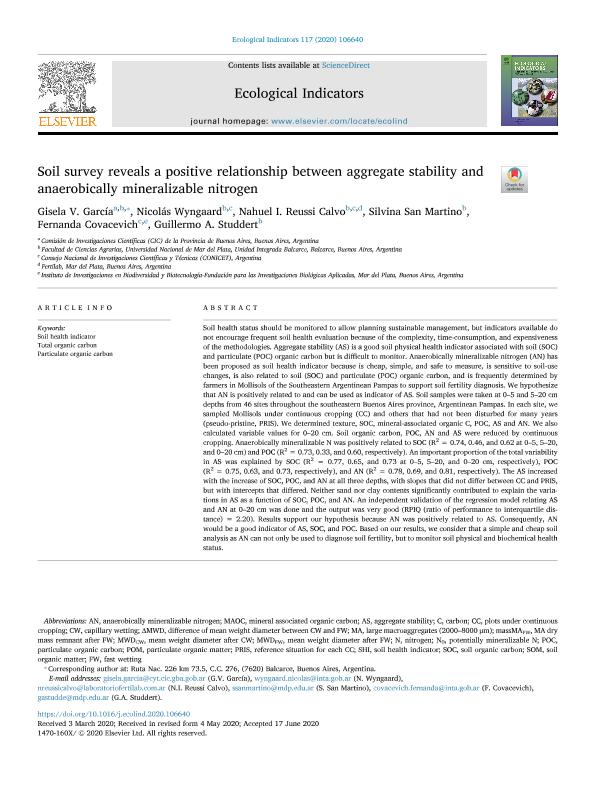Mostrar el registro sencillo del ítem
dc.contributor.author
García, Gisela Vanesa

dc.contributor.author
Wyngaard, Nicolás

dc.contributor.author
Reussi Calvo, Nahuel Ignacio

dc.contributor.author
San Martino, Silvina

dc.contributor.author
Covacevich, Fernanda

dc.contributor.author
Studdert, Guillermo Alberto

dc.date.available
2022-10-20T18:30:58Z
dc.date.issued
2020-10
dc.identifier.citation
García, Gisela Vanesa; Wyngaard, Nicolás; Reussi Calvo, Nahuel Ignacio; San Martino, Silvina; Covacevich, Fernanda; et al.; Soil survey reveals a positive relationship between aggregate stability and anaerobically mineralizable nitrogen; Elsevier Science; Ecological Indicators; 117; 106640; 10-2020; 1-10
dc.identifier.issn
1470-160X
dc.identifier.uri
http://hdl.handle.net/11336/174250
dc.description.abstract
Soil health status should be monitored to allow planning sustainable management, but indicators available do not encourage frequent soil health evaluation because of the complexity, time-consumption, and expensiveness of the methodologies. Aggregate stability (AS) is a good soil physical health indicator associated with soil (SOC) and particulate (POC) organic carbon but is difficult to monitor. Anaerobically mineralizable nitrogen (AN) has been proposed as soil health indicator because is cheap, simple, and safe to measure, is sensitive to soil-use changes, is also related to soil (SOC) and particulate (POC) organic carbon, and is frequently determined by farmers in Mollisols of the Southeastern Argentinean Pampas to support soil fertility diagnosis. We hypothesize that AN is positively related to and can be used as indicator of AS. Soil samples were taken at 0–5 and 5–20 cm depths from 46 sites throughout the southeastern Buenos Aires province, Argentinean Pampas. In each site, we sampled Mollisols under continuous cropping (CC) and others that had not been disturbed for many years (pseudo-pristine, PRIS). We determined texture, SOC, mineral-associated organic C, POC, AS and AN. We also calculated variable values for 0–20 cm. Soil organic carbon, POC, AN and AS were reduced by continuous cropping. Anaerobically mineralizable N was positively related to SOC (R2 = 0.74, 0.46, and 0.62 at 0–5, 5–20, and 0–20 cm) and POC (R2 = 0.73, 0.33, and 0.60, respectively). An important proportion of the total variability in AS was explained by SOC (R2 = 0.77, 0.65, and 0.73 at 0–5, 5–20, and 0–20 cm, respectively), POC (R2 = 0.75, 0.63, and 0.73, respectively), and AN (R2 = 0.78, 0.69, and 0.81, respectively). The AS increased with the increase of SOC, POC, and AN at all three depths, with slopes that did not differ between CC and PRIS, but with intercepts that differed. Neither sand nor clay contents significantly contributed to explain the variations in AS as a function of SOC, POC, and AN. An independent validation of the regression model relating AS and AN at 0–20 cm was done and the output was very good (RPIQ (ratio of performance to interquartile distance) = 2.20). Results support our hypothesis because AN was positively related to AS. Consequently, AN would be a good indicator of AS, SOC, and POC. Based on our results, we consider that a simple and cheap soil analysis as AN can not only be used to diagnose soil fertility, but to monitor soil physical and biochemical health status.
dc.format
application/pdf
dc.language.iso
eng
dc.publisher
Elsevier Science

dc.rights
info:eu-repo/semantics/openAccess
dc.rights.uri
https://creativecommons.org/licenses/by-nc-nd/2.5/ar/
dc.subject
SOIL HEALTH INDICATOR
dc.subject
TOTAL ORGANIC CARBON
dc.subject
PARTICULATE ORGANIC CARBON
dc.subject.classification
Ciencias del Suelo

dc.subject.classification
Agricultura, Silvicultura y Pesca

dc.subject.classification
CIENCIAS AGRÍCOLAS

dc.title
Soil survey reveals a positive relationship between aggregate stability and anaerobically mineralizable nitrogen
dc.type
info:eu-repo/semantics/article
dc.type
info:ar-repo/semantics/artículo
dc.type
info:eu-repo/semantics/publishedVersion
dc.date.updated
2022-09-16T20:51:39Z
dc.journal.volume
117
dc.journal.number
106640
dc.journal.pagination
1-10
dc.journal.pais
Países Bajos

dc.journal.ciudad
Amsterdam
dc.description.fil
Fil: García, Gisela Vanesa. Provincia de Buenos Aires. Gobernación. Comisión de Investigaciones Científicas; Argentina. Universidad Nacional de Mar del Plata. Facultad de Ciencias Agrarias; Argentina
dc.description.fil
Fil: Wyngaard, Nicolás. Consejo Nacional de Investigaciones Científicas y Técnicas. Centro Científico Tecnológico Conicet - Mar del Plata; Argentina. Universidad Nacional de Mar del Plata. Facultad de Ciencias Agrarias; Argentina
dc.description.fil
Fil: Reussi Calvo, Nahuel Ignacio. Consejo Nacional de Investigaciones Científicas y Técnicas. Centro Científico Tecnológico Conicet - Mar del Plata; Argentina. Consejo Nacional de Investigaciones Científicas y Técnicas; Argentina. Laboratorio de Suelo S.a.; Argentina
dc.description.fil
Fil: San Martino, Silvina. Universidad Nacional de Mar del Plata. Facultad de Ciencias Agrarias; Argentina
dc.description.fil
Fil: Covacevich, Fernanda. Universidad Nacional de Mar del Plata. Facultad de Ciencias Agrarias; Argentina. Consejo Nacional de Investigaciones Científicas y Técnicas. Centro Científico Tecnológico Conicet - Mar del Plata. Instituto de Investigaciones en Biodiversidad y Biotecnología; Argentina. Fundación para Investigaciones Biológicas Aplicadas; Argentina
dc.description.fil
Fil: Studdert, Guillermo Alberto. Universidad Nacional de Mar del Plata. Facultad de Ciencias Agrarias; Argentina
dc.journal.title
Ecological Indicators

dc.relation.alternativeid
info:eu-repo/semantics/altIdentifier/url/https://www.sciencedirect.com/science/article/pii/S1470160X2030577X
dc.relation.alternativeid
info:eu-repo/semantics/altIdentifier/doi/https://doi.org/10.1016/j.ecolind.2020.106640
Archivos asociados
